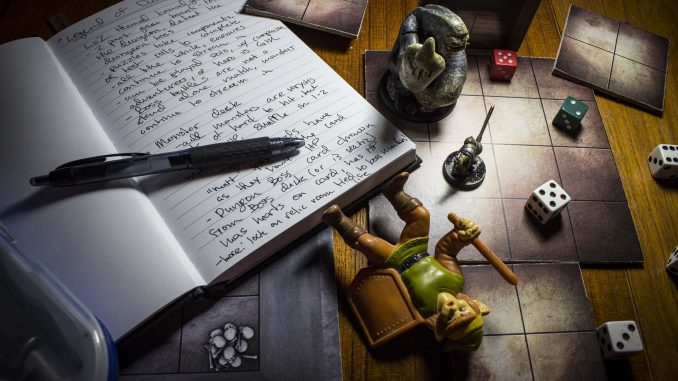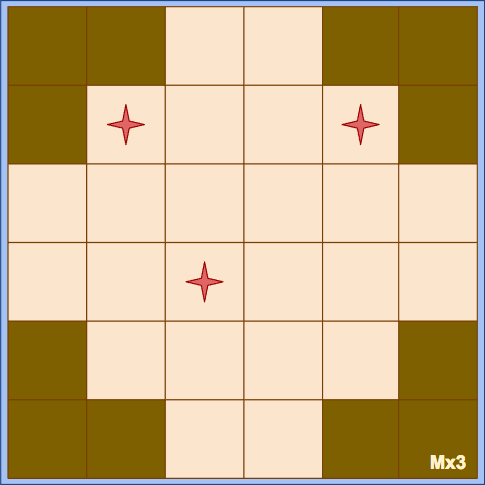
This post is part of an ongoing series. I’m documenting my journey through what I’m hoping is my first successful Game Design project start to finish. I’ve tried to start several ideas in the past, this one I’m determined to see through. Part 2 can be found HERE. In this post I’m going to dive into the mechanics behind building a randomized game board that is unique and engaging for each play through.
Part the Third! Let’s Dive into Some Game Design Mechanics!
In front of me now is the opportunity to divine all of the mechanics of this game from thin air. My last post I focused on starting my game design project with a giant overarching outline. In that vein, an outline of what mechanics I want will help me figure out where I need to start. Here is what I know the game needs to start with:
- Randomized wilderness to be explored in hopes of finding a dungeon
- Randomized dungeon to be explored in hopes of finding a magical artifact
- A means in which baddies populate both the wilderness and dungeon that puts pressure on the hero players to keep moving and not sit still
- The logic that drives enemy movement on the board that is simple and efficient to manage each turn.
- An initiative system that creates a less predictable turn order that is not hard to follow but keeps each round of play fresh and suspenseful.
- Unique combat system that is both simple to handle yet offers a way for individual heroes to chain and combo their attacks
There is no GM in this game. I don’t want to write any rules that require a GM. I personally love running tabletop RPGs, but this game NEEDS to be simple enough to not require a GM to run the “automation”. This, I believe, will be my biggest challenge in the design of the game mechanics for Legend of Hero.
To me, every single one of those bullets actually looks fun to dive into. I’m slightly leery of the initiative system and enemy action logic. These mechanics will be complex to design and are the items that might slow the game down too much or begin to feel like work for the players. Starting there would help me get the hardest part done first, but I don’t think I can do any of these without knowing how the game board will randomly come together and what each game tile will actually look like.
So that is where I must begin.
A Randomized Game Board: A New Adventure Every Time, What Do I Need?
I really need to figure out both what the grid on each tile will look like and how they will randomly build out into an interconnected wilderness/dungeon. These two elements will go hand in hand. Do I want a grid of squares? Hexes? Triangles? Pony outlines? Squares is the easiest to start designing around, so I will start there. I’m considering hexes to revisit in the future as it will offer a more unique dynamic with how the heroes will come into contact with the enemies they encounter. Hexes also feel more organic to me and my visually lend to a more interesting look in the end.
Starting with squares, I’m thinking that the tiles could look something like this 6×6 format below:

The 4 pointed red stars would represent enemy spawn points. I have thoughts on this; there will be an enemy deck that the players draw from depending on how many spawn points there are on the card. I’m also starting to think that to keep the pressure on, after so many rounds into the game play, enemies will start spawning in waves at the player starting tile and always march towards them.
Speaking of a start point, a “Wilderness Start Tile” sounds like just what the Witch Doctor ordered! All players will start on the “Wilderness Start Tile”, it will be closed off on the South side with an open path on the West, North, and East sides of the tile (This is subject to change, all sides might wind up open). No enemies will start on this tile to begin with.
So, imagine a game like the first Legend of Zelda in terms of what kinds of locations you find on your way to the dungeon. Maybe an item shop, a creepy cave, or a fairy fountain. I’m not taking these ideas verbatim, but there should be distractions along the way. The point is to keep the players pressured to move by waves of incoming enemies as they try to locate the entrance to a dungeon. (Guess that means I need a “Dungeon Entrance Tile” too.) I’m thinking some pit stops along the way will be good to offer the players a choice if they are on the ropes. Do we lose some time to refill a bit, or do we cut our losses and push on? (The dungeon can’t be that far, right??) This push on the players should be the same in the dungeon as well as the wilderness.
So as a baseline for the wilderness I know roughly what I need in terms of tiles. This would be mirrored to a degree with the dungeon. None of these are defined in absolute function, but here is the working list so far:
Wilderness Tiles
- Wilderness Start Tile (x1)
- Generic Wilderness Tiles (x10-30?)
- Bandit’s Cache (x1)
- Healing Spring (x1)
- Cursed Wood (x1 or 2?)
- Dungeon Entrance Tile (x1)
Dungeon Tiles
- Dungeon Start Tile (x1)
- Generic Dungeon Tiles (x10-30?)
- Treasure Room (x1)
- Trap Room (x1-4?)
- Boss Room (x1)
In general, I know I’m going to need large piles of generic tiles since the special tiles should come up as a surprise. That mix will get hashed out when I am ready to start a bit of testing.
Randomized Game Board Generation Logic, the Initial Mix
The final formula will ultimately depend on the generic tiles needed for both the Wilderness and the Dungeon, but there are a few knowns. The “start” tile will always come up first and will just be placed. “X” amount of tiles will need to be placed before the entrance to the dungeon or the boss room can be discovered.
- Place the Wilderness Start tile in the middle of the table
- Set aside the Bandit’s Cache tile and the Dungeon Entrance tile
- Shuffle together the Wilderness Tiles and set aside face down, this is now your Draw Pile
- Set aside “X” tiles face down in a stack, this is now the start of the Exploration Deck
- Take “Y” tiles from the Draw Pile and shuffle in the Bandit’s Cache tile. Place these face down at the bottom of the Exploration Deck.
- Take “Z” tiles from the Draw Pile and shuffle in the Dungeon Entrance tile. Place these face down at the bottom of the Exploration Deck.
The process for the building of the Exploration Deck of tiles for the dungeon would be roughly the same. Through play testing, I will define values for “X”, “Y”, and “Z”. Although now I have my basic game plan established!
Part of what will really make this work will be having some fun and unique tiles that build suspense in the draw. Even dead end tiles and tiles with one way in and one way out will build suspense in the reveal. Imagine running down a long hall, monsters hot on your tail only to reveal a dead end! I will have to be careful to have these moments be possible as a point of excitement but not so common that it becomes an inevitability.
What’s Up Next?
That seems like a good place to break. I have now built out some basic logic to a randomized game board that is potentially exciting and suspenseful! I’m not quite ready to do testing yet, so next post will be another dive into some more mechanics, maybe hero movement couples with enemy spawning and movement.
Thanks for reading, please feel free to comment below or on our Facebook page!
